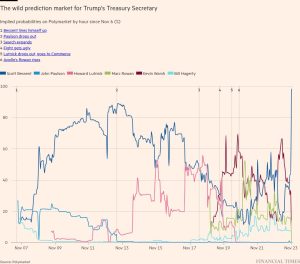How Harris and Trump court Latino voters
This article is an on-site version of our Swamp Notes newsletter. Premium subscribers can sign up here to get the newsletter delivered every Monday and Friday. Standard subscribers can upgrade to Premium here, or explore all FT newsletters
America’s Latino community is large and powerful. Latino voters make up a fifth of the US electorate, and if they were tallied as an economy, they’d be the second-fastest growing one in the world, right after China. Succeeding politically with this part of the country is crucial to winning the election.
But, as my colleague Myles McCormick wrote in a very good Big Read in August, not all Latino voters are alike. You’ve got Cuban Republicans in Florida, socially conservative evangelicals in the Midwest, wealthy small-business owners and blue-collar workers alike. While many lean conservative for cultural and religious reasons, plenty of Latinos are wary of the hard line Maga approach to immigration. Trying to appeal to this group as a whole is tricky. So, I thought I’d take a moment to lay out my thoughts on how each candidate is doing.
If you look at the issue from a national level, it appears that Harris is well out in front. A Pew study from early September found that 57 per cent of registered Latino voters were in her camp. Interestingly, these people aren’t voting on race, gender or identity issues, but rather on their sense that Harris is a safer pair of hands on issues such as the economy and immigration, as well as the idea that she is channelling “pride” and “hope”, rather than “unease” and “anger”, like Trump.
That said, Harris’s Latino base is stronger among women and younger people, many of whom live in blue states where their vote will be less electorally impactful than in the swing states throughout the Midwest, West, and South. It’s also worth noting that Latino voters as a whole are typically less engaged than other registered voters in presidential elections.
Among Latinos, Trump’s strongest appeal is among men, who may be more likely to buy into his socially conservative vision of the family, and his economic message, both in terms of cost of living issues and lower taxes and less regulation. In Arizona, where both candidates have travelled in recent days, 57 per cent of older Latino men support Trump and 51 per cent of younger ones do.
But if you look beyond these numbers to anecdotes, I’d say that Harris is doing a better job of strategically courting Latino voters than Trump is. I was struck, for example, by her decision to talk up her home healthcare plan on The View, a popular American daytime talk show with a Latina co-host, which is watched predominately by women. Black and brown women make up the majority of the labour force in home healthcare, with about a quarter of the jobs done by Latina women. Her care economy message, and in particular the notion of putting Medicare resources behind these jobs to enhance pay and stability, is bound to resonate. I’m also hearing from labour leaders in the care economy that Harris has a much better ground game in swing states than Trump does.
Indeed, Trump’s Latino strategy is incoherent at best. He’s pushing things like stop-and-frisk, a policing strategy that tends to target more people of colour, and shows up to rallies where he seems not to even know the minority pop stars he’s introducing. The free haircuts in Pennsylvania, and the small business roundtables in Georgia and Nevada (where the candidates will also be in coming days) are probably a better bet. They play more to male Latino voters who are all about the economy.
But this is a game of inches, as Trump’s own political director James Blair has put it, and despite Democrats’ worries, it’s not really clear to me that he’s gaining serious ground, except among older Latino men.
Peter, you are closer to this issue than I am — what’s your take about how each candidate is courting the Latino vote? We will see surprise divergences in the Latino voter results as we did in 2020? And if so, where will they be?
Recommended reading
-
The New Yorker usually doesn’t do swing-state class and economic issues, so I was interested to see them pick up on the labour politics of Pennsylvania in this very good feature which tracks the Harris-Walz campaign’s efforts to make sure they don’t lose the working class voters that Biden won back from Trump.
-
In the wake of two major hurricanes over the past few weeks, I have climate change on the brain, and so also enjoyed two other New Yorker features on the topic, one tracking how Asheville, a mountain town in North Carolina that is far from the sea, was destroyed by hurricane-related flooding.
-
Then, there’s the always great Elizabeth Kolbert (author of The Sixth Extinction) on the melting Greenland ice walls, and how they may be creating a feedback loop that’s partially responsible for recent extreme weather events.
-
For my own take on the storm, I looked at the mass migration towards the highest risk areas in the South and West of America over the past few years, and what it could mean for business and the economy.
Peter Spiegel responds
Rana, Karl Rove, George W Bush’s political Svengali, was the first prominent Republican to argue that the natural electoral home for Latinos was in the centre-right. As far back as Bush’s first campaign for Texas governor in 1994, Rove urged the presidential scion to travel to traditional Democratic strongholds like El Paso to dent their advantage among Mexican-American voters.
Rove’s logic was as straightforward as it was revolutionary: Latinos were overwhelmingly Catholic and culturally conservative; they were hardworking and entrepreneurial; and they were proudly patriotic. That sounded a whole lot like the Republican party’s traditional voter base. Bush did astoundingly well for a Republican gubernatorial candidate in Texas (garnering about 40 per cent of the Latino vote) and respectably when he ran for president in 2000 (about 35 per cent).
It would seem absurd to draw a straight line from Bush to Trump when it comes to the Latino vote. Where Bush actively courted Mexican-Americans, Trump has gone so far as to label Latin American migrants as “rapists” who are “poisoning the blood of our country”.
But an important thing has happened in the ensuing three decades: the Latino experience in America has changed from that of the immigrant community to one that is more mainstream. Second and third generation Mexican-Americans now share many of the same political instincts of their non-Latino neighbours. For them, everyday economic concerns are more important than issues that were once seen as specifically important to the Latino community, like immigration and civil rights.
A new New York Times poll has put that into stark relief: only 20 per cent of Latino voters said they view the current US economic conditions as good or excellent. More than half said they have had to cut back on essentials because of high prices. For those who say the economy is the most important issue, Trump leads Harris by a 61-35 per cent margin.
For Harris to win back these Latino voters, she has to do the same thing she’s struggling to do with the rest of the electorate: convince them she has a plan to tame inflation and break from Bidenomics.
So far, she’s announced incremental changes in Biden’s economic plans, like the home healthcare plan you mentioned. But those aren’t big, visionary changes like the kind Biden initially ran on in 2020, or those that her Democratic presidential predecessors like Barack Obama (the Affordable Care Act) or Bill Clinton (welfare reform, Nafta) ran on. Without winning over Latinos on economic issues, I think she’ll struggle to reverse some of the losses Democrats have seen among Latino voters.
Your feedback
We’d love to hear from you. You can email the team on [email protected], contact Peter on [email protected] and Rana on [email protected], and follow them on X at @RanaForoohar and @SpiegelPeter. We may feature an excerpt of your response in the next newsletter
Recommended newsletters for you
US Election Countdown — Money and politics in the race for the White House. Sign up here
Unhedged — Robert Armstrong dissects the most important market trends and discusses how Wall Street’s best minds respond to them. Sign up here
#Harris #Trump #court #Latino #voters





